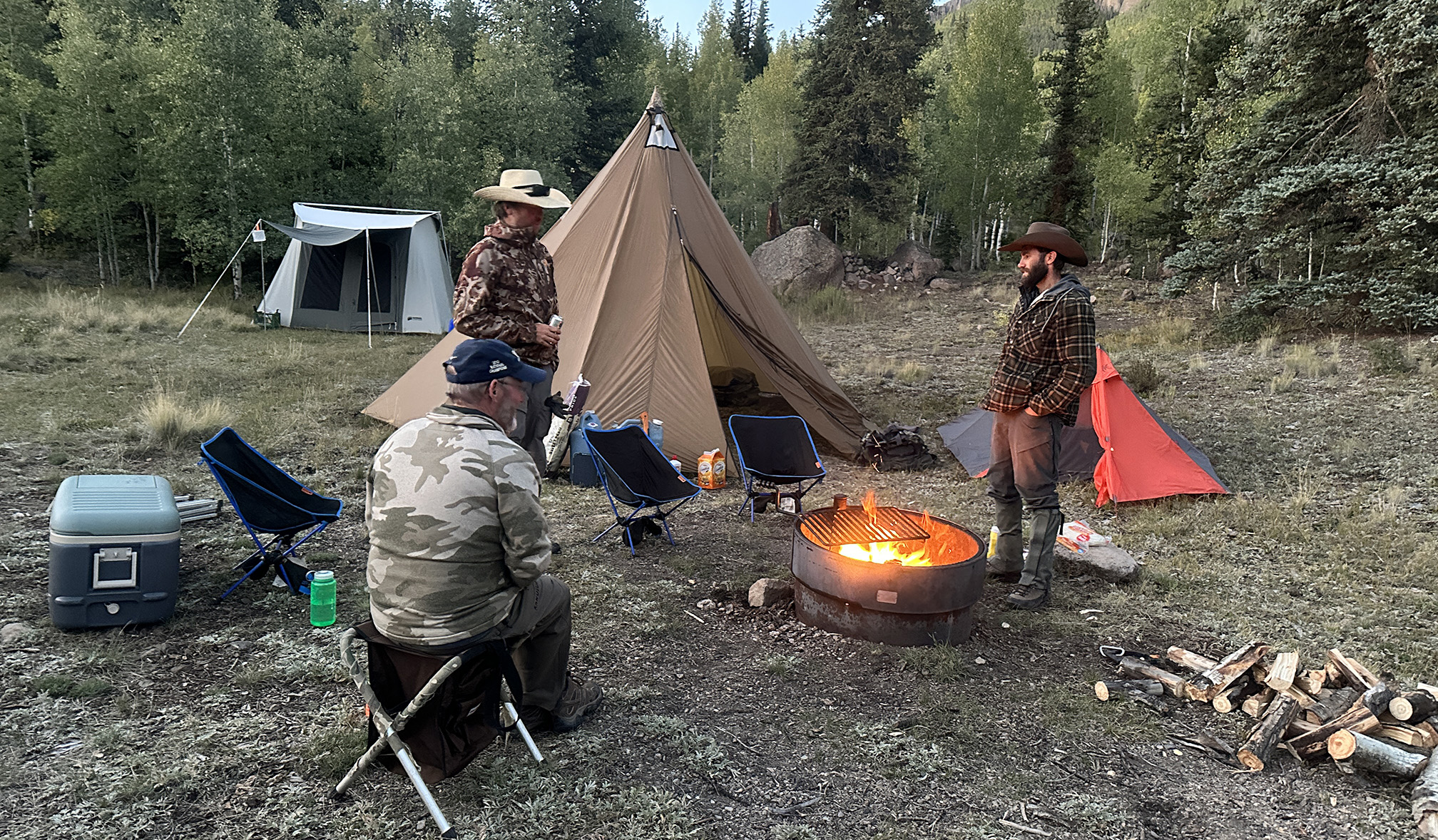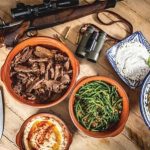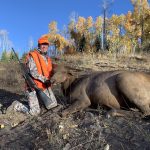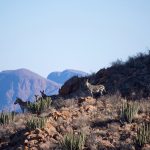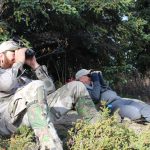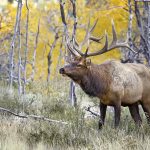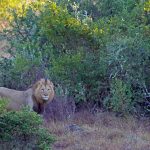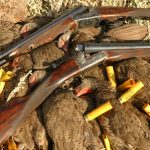Hunting a bighorn ram high in the Colorado Rockies.
I stared pensively into the flames of the campfire as they popped and crackled, consuming the aspen logs and sending a fragrant plume into the September sky. Mingling with the wood smoke was the delicious aroma of elk brats roasting on a metal grate propped atop the logs. It was a glorious evening at our sheep camp at 9,500 feet in the Colorado Rockies, and the last glow of sunset had painted an orange blush on the rocky peaks that surrounded us. But when I glanced up at those ramparts I felt like they were daring me to scale them, and making it plain they cared not one whit whether I succeeded.
Under normal circumstances, I would have been relaxing and reveling in this wonderful place. Instead, I tore my gaze away from the crags and looked back at the campfire, sipping a Gatorade, my stomach churning with nerves and my mind riddled with doubts. Can I do this? Am I in good enough shape? Will we see a good ram? If we do, can I make the shot?
Drawing a Rocky Mountain bighorn sheep tag had been an incredible stroke of good fortune, but I had not anticipated the stress I felt once I had the coveted permit in hand. If a bighorn tag is not once in a lifetime, it’s close enough. If you don’t fill it, it’s very unlikely you’re ever going to get a second chance. The pressure I had put on myself had been building all summer as the hunt got closer, and now, the evening before opening day in my unit, it felt as crushing as a hundred-pound pack.
Around me was the low, reassuring murmur of conversation from my hunting team. My guide, Jesse Bauer, and the two assistant guides, Trevor and Chad, were whipsaw-thin and tough as rawhide, sharp-eyed veterans of the high country with decades of sheep-hunting experience between them. My husband, Scott, had given up his elk tag and spent the summer getting into sheep shape with me so he could come along to provide motivation, support, and an extra set of eyes. He had even loaded his pack with extra water, food, and gear so I could go in as light as possible.
In short, I had quite possibly the best sheep-hunting team in the state of Colorado in my corner. But there were so many wild cards: The mountains. The weather. The sheep themselves. And, of course, me.
Unexpected Challenges
I had first set foot in the magnificent San Juan Mountains of southwestern Colorado a month prior, when Scott and I had made the eight-hour drive from our home in northern Colorado to accompany sheep guide Justin Adkisson and his son, Ridge, on a scouting trip.
The country was everything I had imagined in my sheep-hunting dreams: steep, rugged mountains flanking long, narrow valleys, high alpine meadows filled with lush grass and tiny wildflowers, hot sun and cool breezes, the coarse calls of magpies and Steller’s jays, and trickling headwater creeks filled with native Rio Grande cutthroat trout.
We went in on four-wheelers, rumbling up the trail until it narrowed to singletrack, and then parking the vehicles and making a circuitous nine-mile hike, all of it at more than 10,000 feet of elevation. Following rumors of ram sightings passed on by the inhabitants of a backcountry fishing camp, we climbed and glassed, and climbed and glassed some more, spotting only a group of ewes. This time of year, Justin explained, the rams and ewes stayed in separate herds, but the rams would often be just one drainage over.
We went back to the four-wheelers and negotiated a rocky trail into the next drainage. Justin’s sheep savvy proved correct, and we spent the afternoon and evening glassing a group of rams very high on the crest of a ridge and studying what looked like a good one in the mix. I was simultaneously thrilled at finding rams and humbled by the difficulty of the terrain. I had been working out hard, and I had a month left. I determined to double my efforts in the time remaining.
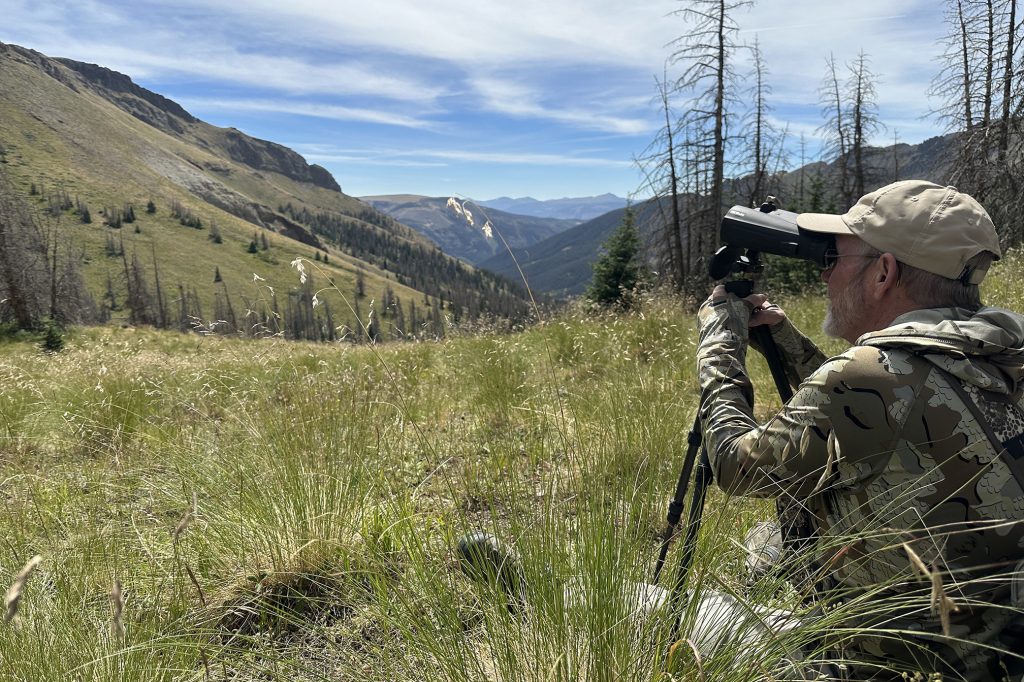
But on the way back to the trailhead that evening, disaster struck when the four-wheeler I was on rolled over on a sharp turn. Just before it flipped, I jumped off, landing on my left leg, hard.
It could have been a lot worse. A trip to urgent care when I got home showed no bones broken, but I was in significant pain, barely able to hobble around the house, much less hike. I rehabbed the injury with single-minded determination, and a little more than two weeks later I was hiking again, albeit with a marked decline in my hard-won fitness level.
Around the same time, I began to have problems with my rifle. The groups I shot with the rig I had planned to use were unsatisfactory, and it developed feeding problems to boot. I turned to the trusty rifle I had been using on our DIY elk hunts, a Ruger American .30-06. It was lightweight, accurate, and dependable—everything a sheep rifle needs to be.
I topped it with the Swarovski scope that had been on the other rifle, joking to Scott that my scope cost four times as much as my rifle. During the weeks I couldn’t hike, I spent my mornings at the shooting range, practicing out to 300 yards, lying on a prone mat and shooting off my pack.
At last, just days before the hunt was to begin, my leg was healed and I had a rifle in hand I trusted. Scott and I loaded our truck with camping gear, hunting packs, rifle, ammo, and two big coolers, and we hit the road for the high country.
Into the Mountains
Trevor had spotted a nice ram several days prior to our arrival, but he had not been able to find it since then. So at daylight on the first morning, the plan was for the five of us to split up and glass the two drainages we had scouted back in August. Jesse, Scott, and I headed up the drainage where the ATV wreck had occurred, while Trevor and Chad hiked up the valley just to the west of it, where we had seen the ewes on our scouting trip.
The morning dawned clear and beautiful—a perfect fall day, and I felt much better as soon as we started hunting. My head cleared, my insides unclenched, and my mind focused on the task at hand. The three of us scoured the mountainside thoroughly with our binoculars and spotters, seeing nothing but a few elk. Some three hours later, Jesse was certain the rams weren’t in this drainage. It was time to go join Trevor and Chad.
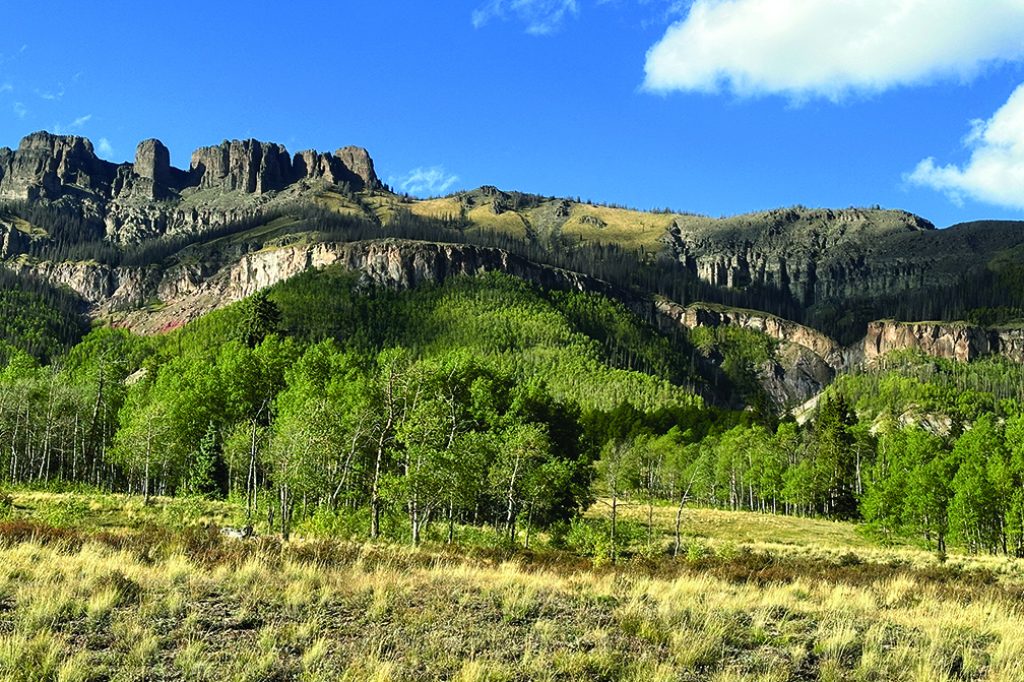
We left the ATVs where the trail narrowed to a footpath and shouldered our packs for the hike up the next drainage. After about a mile and a half, we found Trevor sitting next to the trail, glued to his spotting scope, which was trained on the opposite ridge. I plopped down beside him and he gestured for me to take a peek. I held my breath as several blocky gray forms came into focus through the glass. Rams!
There were probably a dozen rams in the group, mostly four- to six-year-olds, and we spent the morning enjoying watching them feed, sniff each other, lick rocks, and do other sheepy things. Just before midday, they went into a copse of trees and bedded down.
In the meantime, Jesse and Chad had climbed the slope behind us, where they had a higher vantage and could see a group of four rams a little way past and above the bunch we were watching—and one of them looked big. They were bedded in a rocky, cliffy spot, but Jesse thought we might be able to get to within 300 yards of them, if the wind didn’t change and the other group of rams didn’t blow our stalk.
We discussed the problem at length. Scott studied the grass on top of the ridge through his 15X binocular and determined the wind was blowing left to right up on the ridge. He said that if we stayed to the right of the young rams, we should be able to get around them to where the big ram was without spooking them. But it was a risk.
In the end, Jesse looked at me. “It’s your call,” he said. “That ram is in a tough spot. We can climb the mountain and try it, but there are no guarantees it will work. We might blow it. We can also watch him and wait to see if he moves into a place where it would be easier for us to stalk him.”
I had already made up my mind, and it wasn’t a hard call. There was a big ram up there on the mountain. The stalk might or might not work, but one thing was for sure: I wasn’t going to kill him sitting down here.
“Let’s go,” I said. The midday sun was warm, and I stood up and began stripping off all my outer layers and stuffing them in my pack. Everyone else followed suit.
It wasn’t an overly long climb, but it was straight up, more than a thousand feet of elevation gain, and the altitude made it brutally tough. I followed Jesse, and Scott and Trevor followed me, while Chad stayed at the base of the mountain to watch the proceedings unfold through his spotter; that way, if we spooked the rams, he would be able to see which way they went, and if we were successful, he would come up and join us to help pack out the ram.
The first part of the climb involved clambering through thick timber and over deadfalls. My legs felt like someone had hung lead weights on them, and I hauled myself up the slope by grabbing bushes and small saplings. Finally we were above timberline, and a near-vertical slope stretched before us, all rock and loose scree.
Once we got up there, everything started to go wrong. The wind, which had been blowing lightly but steadily left to right as Scott had seen, switched, and with horror, I felt it touch the back of my neck. Shortly afterward, I dislodged a large rock, which bounded down the mountain sounding like a drum solo at a rock concert. We all froze, clinging to the unstable scree. A moment later, I saw a young ram run across the cliff face to our front. I was sure we were busted.
But Jesse kept going, picking his way across the loose rock, and I followed him, taking extra time to place my feet as carefully as I could. A pika scurried in front of me with some plants in its mouth and ducked under a rock. Then I saw Jesse crawl up to a little notch with a rock ledge almost like a windowsill and peer over it with the rangefinding binocular I’d loaned him.
I dropped to my knees, stripped off my pack, unclipped the rifle from it, racked a round into the chamber as quietly as possible, checked the safety, then crawled up behind him, pushing the pack and rifle ahead of me. A huge alpine bowl opened in front of me, studded with enormous boulders.
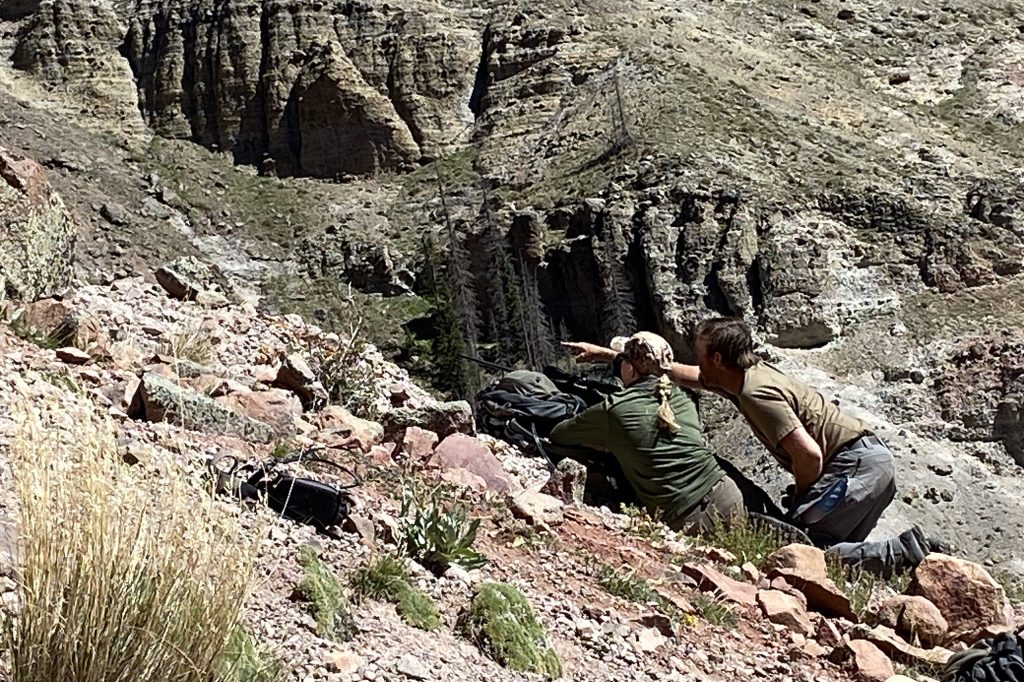
Jesse hand-signaled two-six-zero. I felt a rush of adrenaline; the sheep were in range. I breathed deeply, slowly eased the pack on top of the rock ledge, and shoved the rifle over it.
Then Jesse said, “They’ve winded us; they’re up.”
My heart sank, sure we had done the tough climb for nothing. But wonder of wonders, the rams weren’t running. They were only standing, looking curiously our way. I settled in prone behind the rifle, working the fore-end into my pack, steadying it just as I had done countless times on the 300-yard range back home.
Jesse talked me calmly onto the rams until I had them in my scope. The big ram, he said, was third from the front. I panned past one, two, and then–wow! This ram was much bigger than the others. He was standing broadside at the base of an enormous boulder, looking right at me. He was the embodiment of every adjective I had ever heard applied to bighorn rams: Royal. Majestic. Magnificent.
Then he took a few steps forward. He was walking, and I wasn’t ready. To my complete astonishment, Jesse bellowed a loud, “BAAA.” The ram stopped and looked toward us again.
My cross hairs were on him, but it wasn’t quite right. This shot had to be perfect. There could be no doubt at all. I breathed, shifted, got steadier. And the ram started walking again.
Once again, Jesse let out a “BAAA!” The ram stopped again, broadside, looking right at me. The rifle was zeroed at 200. I adjusted for the holdover. The cross hairs came steady. It was right. Trigger squeeze. The shot was like a thunderclap in the mountain basin.
And the rams were running.
“You hit him. Reload.” I heard Jesse, but I was already racking the bolt. All four of the rams were running straight up the mountain, including the big ram. Straight up. Not good.
I knew I had to stay calm and make the follow-up shot. I asked Jesse for a range, and he said 300. I reached up and dialed the scope turret to 300 and settled back down behind the rifle to get the ram in my sights. He had stopped. I breathed and steadied myself. And then, before I could do anything else, the ram dropped right out of the scope.
After his initial forty-yard bolt up the mountain, he simply collapsed in his tracks and rolled down the mountain like a loose cannonball. I heard Jesse shout, “He’s rolling!” The bullet had done its job and the tough old ram had been dead on his feet; he just hadn’t known it.
I let out a long breath, rested my forehead on my rifle, and said a heartfelt prayer of thanks. Then I turned to Jesse and gave him a hug. “Thank you so much,” I said.
Jesse’s million-dollar smile was a mile wide. He said, “Thank you for not missing!”
Trevor and Scott came running up with congratulations and hugs. They had been crouched low behind us, and hadn’t seen the ram, but they had seen the shot and our reactions.
Scott said to Jesse, “I heard you go BAAA!”
Jesse said, “I can’t believe that worked!”
After unloading my rifle, I picked my way out into the scree field behind the others. We looked for the ram near the boulder where he had originally stood, thinking he had rolled back down close to it. But he wasn’t there. Trevor ranged farther up the mountain, Scott went to the right, and I stayed close to Jesse, but we were looking for a rock-colored ram in an ocean of rock-colored scree.
I felt panic rising. Had he really been dead? Did he get up and run after that awful fall? Or did he roll all the way to the bottom of the basin, which dropped off in sheer cliffs far below us?
Jesse and Trevor were looking around, shaking their heads, crisscrossing the slope. I had gone from rocket-ship high to a deep low in just minutes. And then I looked up the scree field to my left and saw something yellowish-brown. It was an animal. A large, dead one, with horns.
“Jesse!” I yelled, pointing.
“It’s him!” He shouted, and he and Trevor bounded over.
It seemed to take me forever to get there; it was difficult to move on that loose scree. Scott was right beside me, and we gasped in the thin air, slipping and stumbling in our eagerness to get to the ram. The altimeter on my watch read 11,800 feet.
When I finally got to the ram, the others stood back and I knelt and put my hands around the bases of his magnificent horns, marveling at their mass and how it carried through to the broomed tips of his three-quarter curl. He was everything I had imagined, and more: a fine, mature ram, eight or nine years old. I thought of all the preparation and stress, the hikes, the injury, the mornings of shooting, the dry firing, the workouts, the doubts, the fears. It all came together as I held the ram and looked down from the lofty heights he had called home to my own world far below.
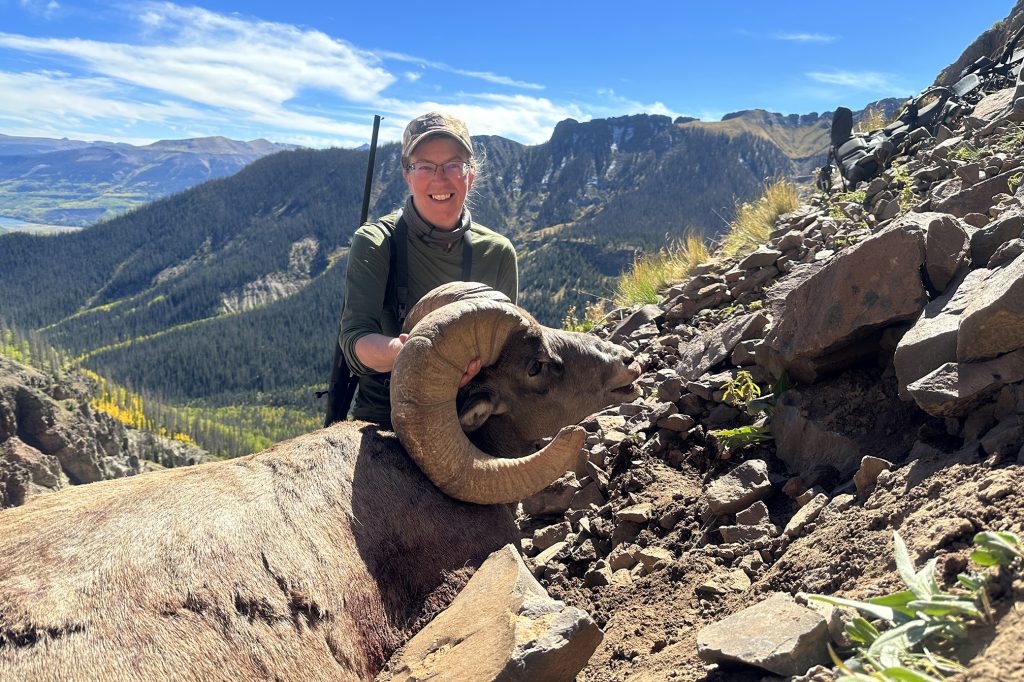
That evening found us around the campfire again. Four ghostly white shapes–the sheep quarters in their game bags–swayed from nearby tree branches where we had hung them to cool. I had trimmed the tenderloins from the ram, sprinkled them with salt and pepper, and laid them on the metal grate over the logs. Exhausted, hungry, and jubilant, our little group of sheep hunters watched in companionable silence as they cooked.
My aching muscles and the bruises I had sustained from countless falls on the way down the mountain with the ram’s head on my back told me it had all really happened. But every few minutes I had to get up and touch the horns, just to be sure.
When I looked up at the jagged peaks above us, silhouetted now against a star-filled sky, I felt humbled and grateful to have briefly been granted entry into the rarefied world of the bighorn sheep. They are the ultimate symbol of these mountains, an integral and essential part of the high country, and of hunters’ dreams.
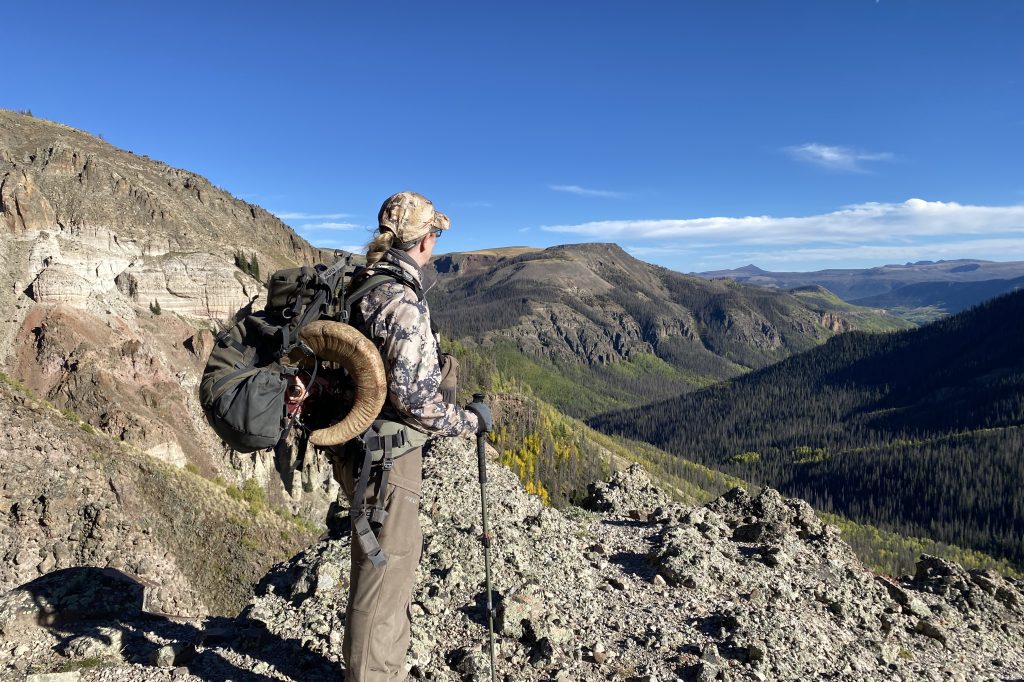
Gear for the Sheep Hunt
My rather unconventional sheep rig was a Ruger American rifle in .30-06 topped with Swarovski’s Z6 2.5-15×44 HD. Weighing just over 7.5 pounds, this turned out to be an outstanding combination, and I wouldn’t hesitate to take it on another high-stakes mountain hunt. Barnes VOR-TX ammo with the excellent 168-grain TTSX bullet shot consistent sub-MOA groups and exhibited deadly terminal performance on my tough old mountain ram.
Top-of-the-line glass is perhaps the most crucial gear item on any sheep hunt. I carried my trusty 10X Swarovski EL Range binocular, which has stood me in good stead on many hunts. At the moment of truth, I handed it to my guide so he could glass and range my ram while I prepared to shoot.
For long hours of glassing, Steiner’s HX 15x56X binocular on a Leupold ProGuide Carbon Fiber tripod proved to be ideal, much more powerful than 10X binocular and far easier to use and pack than a spotting scope. We used it to spot sheep on our summer scouting trip and on the hunt itself. However, I was glad Scott was carrying it up the mountain and not me.
Kuiu’s Pro 3600 is my favorite hunting pack, weighing almost nothing by itself, yet able to handle very heavy loads, including all my gear and the ram head on the way down. I wore my trusty, well-broken-in Kenetrek Mountain Extreme Boots. Without their rock-solid ankle support and aggressive tread, I would have likely fallen off a mountain long before now.—D.R.
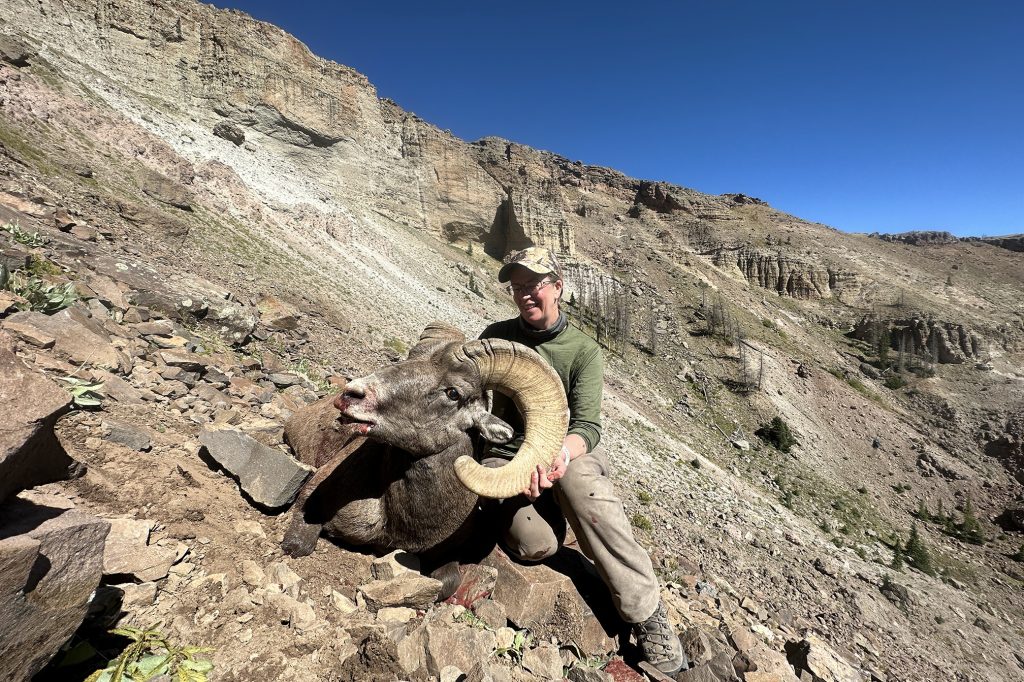
This hunt was outfitted by Rio Grande Outfitters and guided by Justin Adkisson and Jesse Bauer with Crazy Horse Outfitters. For information about backcountry hunts for big game in southwestern Colorado, contact Justin Adkisson at [email protected] or 970-731-HUNT.

